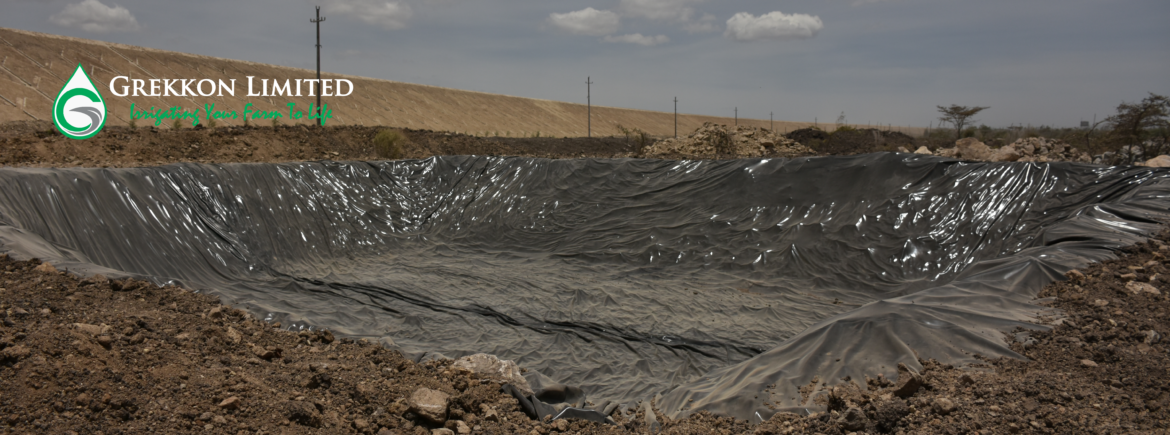
Dam Liners Prices in Kenya
Dam liners prices in Kenya for irrigation by Grekkon Limited vary annually by raw material cost. These dam liners will be installed on reservoirs, or water tanks. Their purpose is to prevent water loss through absorption by the soil surface.
Our dam liner material is high density UV treated geomembrane. UV treatment is to slow down degradation by the sun during external use. Grekkon Limited’s dam liners for sale in Kenya are categorised according to thickness
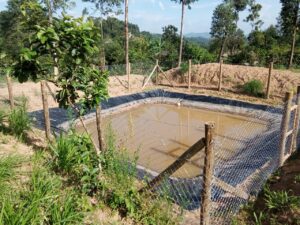
A small water reservoir for vegetable irrigation with a 0.5mm dam liner installed by Grekkon Limited in Emabungo area, Vihiga county. Notice the fence around it fo safety reasons
Dam Liner Prices in Kenya
| Liner Thickness | Material Cost In Kes | Welding Cost In Kes | Installation Cost In Kes | AMOUNT In Kes |
| 0.5mm | 220 | 30 | 30 | 280 |
| 0.75mm | 300 | 30 | 30 | 360 |
| 1mm | 380 | 30 | 30 | 440 |
Introducing the 1.5mm dam liner for Kes 780/M square all inclusive
Notes
- Welding cost applies when the liner required is wider than 8M
- Installation cost is charged when a Grekkon Limited technician installs the liner
Dam Liners Material Thickness Application
- 0.5mm liners are for smooth surfaces without stones or rocks. It will work on a surface with murram. The life span is 8 to 12 years
- 0.75mm liners are for rough surfaces with some stones or rocks. The lifespan is 15 to 20 years
- 1mm liners are for stony or rocky surfaces. The lifespan is over 25 years
The choice of liner thickness is a factor of the liner size. A liner holding 10,000 cubic is thicker than one holding 500 cubic
Dam Liners Prices In Kenya
Processes Every Grower Should Know
I. How to calculate your dam liner size
- Measure your reservoir length (L), width (W) and depth (D) in meters
- Apply the formula; (L+2D+2) + (W+2D+2). This converts your 3D measurement to 2D
II. Steps to install your dam liner
- Clean up your reservoir floor to remove any debris that will perforate the liner
- Lay your liner at the center on the floor of the reservoir
- Spread it out to cover the entire floor, and the walls
- Make a trench 1M away from the edge of the reservoir, all around it
- The trench measure 30cm/ 1ft deep by 30cm/ 1ft wide
- Tuck your liner in this trench, then cover it with lots of soil
III. How To Weld Dam Liners
- Factory welding. Depending on the dam liner size, weld it whole or partially in the factory. The weight and volume of the welded material must be easily portable on site. The latter factor guides on how much of the dam liner material will be put together in the factory
- Site or field welding. This is done on site at the point of dam liner installation. It is the joining together of the partially welded dam liner pieces from the factory. Site welding is done when the entire dam liner could not be wholly put together in the factory. This is as a result of weight or bulkiness, which limits lifting and transportation of the bulky and heavy material. The weight size of the portable material depends on the thickness of the dam liner. The thicker it is, the less it is
- A wedge welding machine or a heat gun/ heat blower is the equipment that does dam liner welding. A wedge machine is what does it in the factory. The heat gun is highly portable, and so is best for field joinery
Dam liner welding involves melting the liner material under high temperature at the point of joining them. Once melted, the 2 layers are laid one over the other and as they harden, become one unit
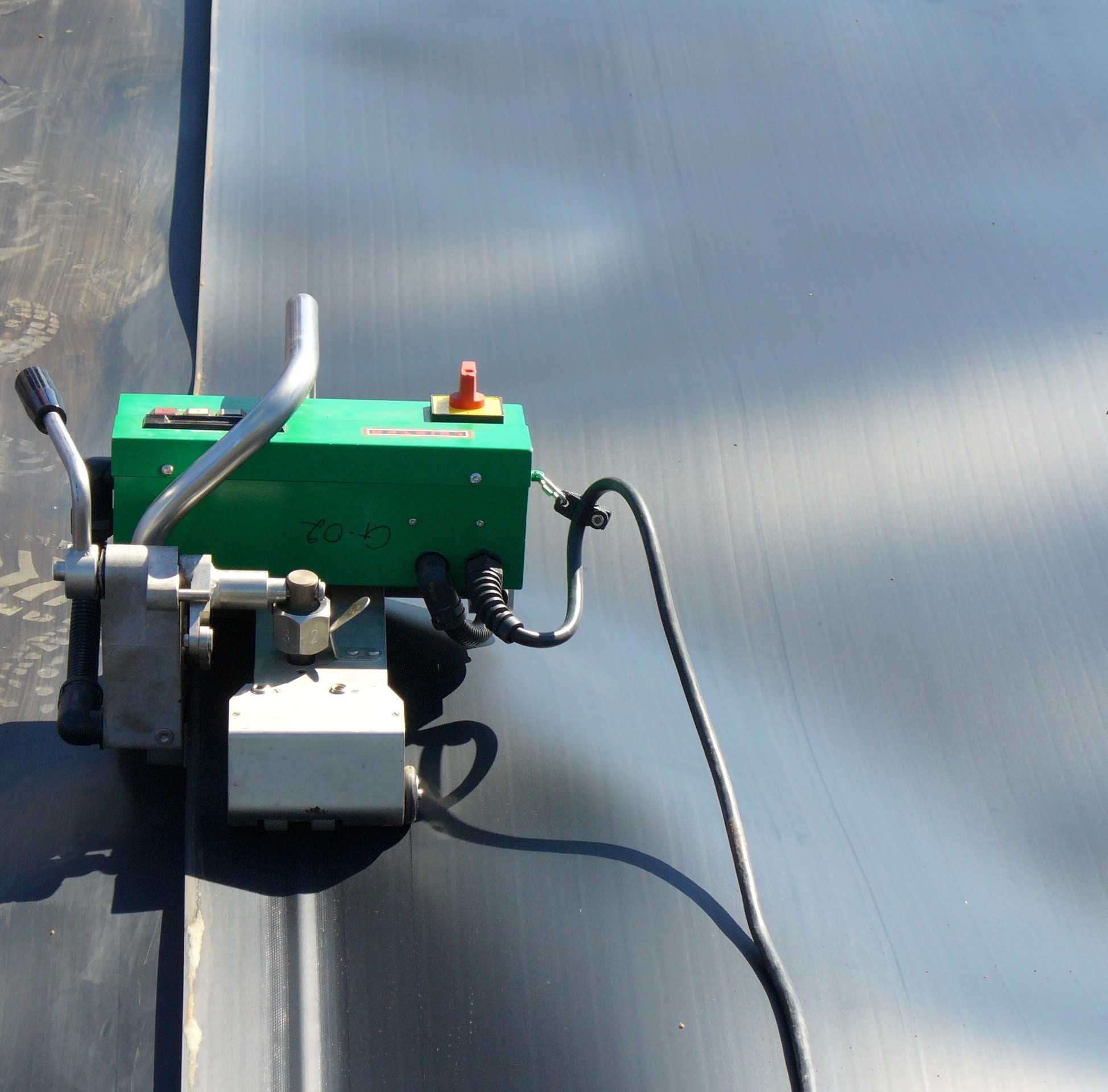
Factory wedge welding of a 1mm thick dam liner
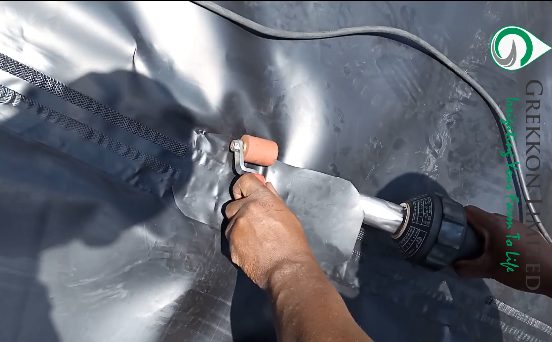
Joining 2 dam liner pieces with a heat gun
IV. How to Harvest Water Using Dam Liners
Factors to consider that will affect your dam liners prices in Kenya
a. Land size
The amount of water required for half an acre is less than that needed for 20 acres. The latter will harvest more water to irrigate the greater acreage, and the former will have less water harvested. The bigger the volume of water reserved, the larger the dam liner size
b. Location
The amount of rain fall is different in every climatic zone. Growers in the cool wet highlands have just a few dry months in the year, while farmers in the dry zones have more dry months than wet. In regions where the interval between rains is long, larger reservoirs are built for the same acreage as that in the cool wet location. Again, dry locations have very high water loss through evaporation. In this case, it is advised to set up a shade net over the water reservoir to manage this water loss
c. Ground Elevation
The farm gradient determines the location of the water pan. Some choose to have it at the lowest part so as to capture run-off water. If it is for crop irrigation, this water is either pumped uphill to a tank from where it flows back by gravity to the crop. Or it is pumped directly to the crop from the water reservoir. Others choose to locate the water pan on the highest point of the farm so that the water, through gravity flows out to the crop. In this case, the farmer does not retain run-off rain water from the farm. On a flat terrain, irrigation water is physically pumped out to either a high storage tank for onward gravity flow to the crop. Or directly to the crop

A low reservoir that collects run-off rain water
d. Farming System
The size of the water pan will differ for irrigation, compared with aquaculture or livestock production
e. Crop Type
Some crops are more water demanding such as leafy vegetables, than others such as herbs. Then some crops like onion are densely spaced while others are like avocado are sparsely populated in the farm. This will determine the water requirement
f. Irrigation System
Every irrigation system has it’s own unique water use. Drip irrigation conserves water while overhead irrigation through sprinklers or rain hose kits spends huge water volumes
g. Surface Texture
The surface texture of the water pan determines the dam liner thickness to install. For a smooth surface, a 0.5mm dam liner is ok. Where the surface is stony or rocky, then the 0.75mm or 1mm dam line is better
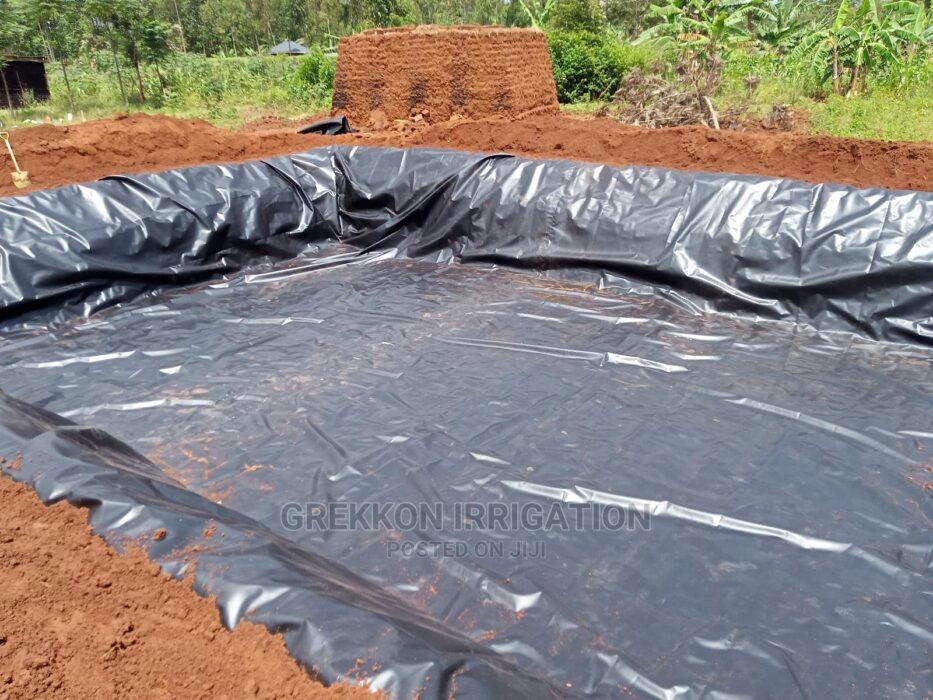
Dam Liner Company In Kenya
Grekkon Limited is the foremost dam liner company in Kenya. From material selection, to welding and installation, our professional teams train growers on all these aspects. It ensures that they make the right choice and why
This is according to the size and nature of their irrigation water reservoirs and tanks. These dam liners in Kenya are UV treated, HDPE geomembrane material in varying thicknesses and weights as tabulated below
| Liner Thickness | Liner Weight/ M SQ |
| 0.5mm | 460g |
| 0.75mm | 880g |
| 1mm | 910g |
The UV treatment reduces radiation damage which is high in tropical countries
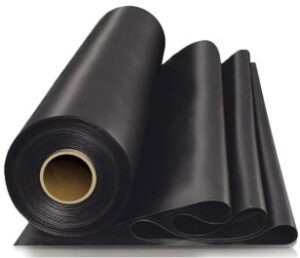
A roll of 0.75mm dam liner
Dam Liner Prices In Kenya
Our dam liner cost in Kenya is broken down into; material, welding, and installation. Once a grower procures a dam liner, s/he will have it welded if the width exceeds 8M. If the farmer chooses for us to install, then the cost of installation applies.
| Liner Thickness | Material Cost (KES) | Welding Cost (KES) | Installation Cost (KES) | AMOUNT (KES) |
| 0.5mm | 220 | 25 | 25 | 270 |
| 0.75mm | 300 | 25 | 25 | 350 |
| 1mm | 380 | 25 | 25 | 430 |
How Are Dam Liners Calculated?
Before determining the dam liner size, one must understand the size of the reservoir or tank. This is by measuring the length, width, and depth/ height (for rectangular or square shaped reservoirs/ tanks). For circular or cylindrical tanks/ reservoirs, measure the diameter, and the depth/ height. The reason this is key is because our dam liner material comes in rolls. To make out the shape of the water pan or tank, the dam liner is cut in large bits from the roll and joined together. This is to create the 2 dimension size of the water reservoir or tank. For example; if the width of the dam liner on the roll is 8M, and the water pan requires a width of 15M. Then 2 pieces, one measuring 8M and another 7M in width from the roll are cut and joined to create the 15M width
How Do I Calculate How Much Dam Liner I Need?
The dam liner calculator is adapted to the shape of the irrigation water reservoir as illustated in the 3 different shapes below
- Sloped sides reservoir

The slope of the dam wall is shown as slanting length (SL) or slanting width (SW) in the dam liner calculator tabulation shown later in this page
2. Cylindrical circular tanks
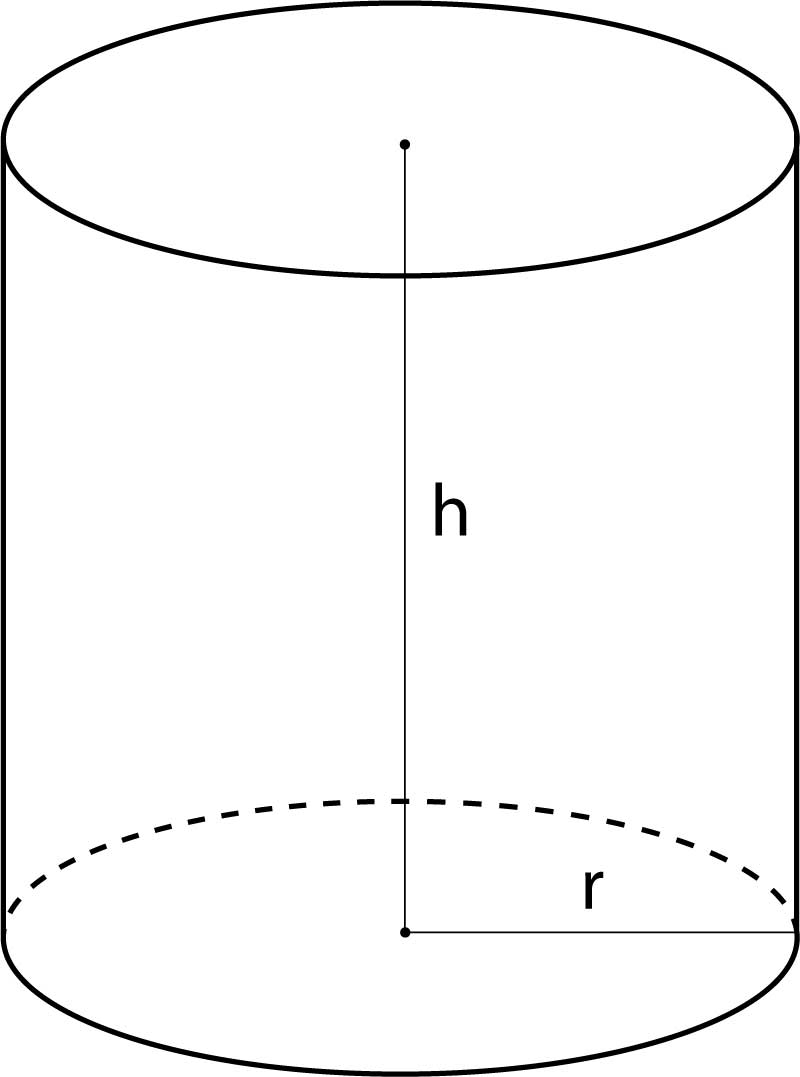
3. Straight side reservoirs
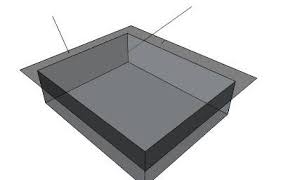
Pond Liner Calculator: Table
| Circular Liner | Sloped Sides Liner | Straight Side Liner |
| (Circumference*H+0.6M) + (3.14*3.14*r+0.6M) | (SL*2+D+2M)*(SW*2+D+2M) | (L+2D+2M) * (W+2D+2M) |
If your totals include a decimal say 120.3sq, round it up to the nearest whole number, in this case 121M sq. The +0.6M in the ‘circular liner’ and is the overlap. So is the 2M in the straight side liner’
“D” is the maximum depth which is the center-most point of the reservoir
Dam Liner Calculator
How much overhang should a pond liner have?
An overhang is the extra liner material that holds the main liner in the reservoir or tank. This excess material is held against the external wall of the tank, or tucked in a trench all around the reservoir to support the dam liner in place. It is covered with soil or stones in the trench. Another alternative to trenching is to lay sand bags on it. The weight of the sand bags holds the dam liner in place
After excavation, it is necessary to compress the mould of soil roundabout the water pan before making a trench
See below
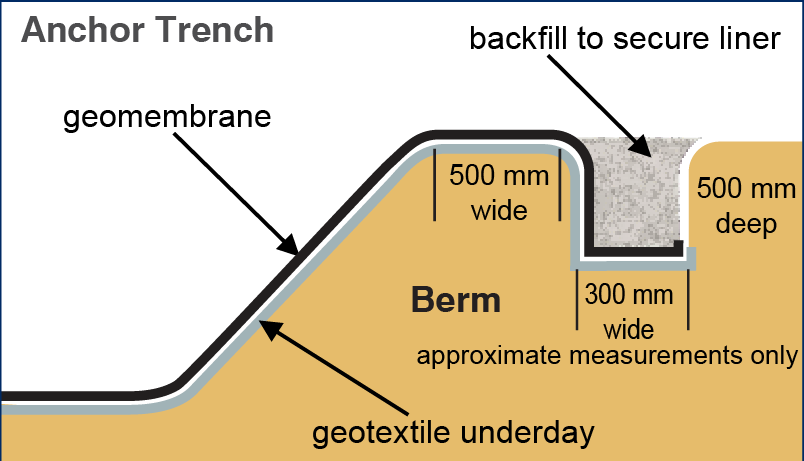
Dam Liner Installation
Our dam liner rolls are 8M wide. So for any width beyond this, the additional size has to be welded on. Welding is carried out fully in the ware house for small liners, and partly in the field for large liners. This is to reduce bulkiness during transportation to site
When installing a dam liner in a reservoir, trench round about the reservoir. This anchor trench is where the liner will be tucked for support
The video below shows a farmer in Nandi county recounting the benefits he has received 2 years later after having his dam liner installed by Grekkon Limited
How To Weld Dam Liners
- Factory welding. Depending on the dam liner size, weld it whole or partially in the factory. The weight and volume of the welded material must be easily portable on site. The latter factor guides on how much of the dam liner material will be put together in the factory
- Site or field welding. This is done on site at the point of dam liner installation. It is the joining together of the partially welded dam liner pieces from the factory. Site welding is done when the entire dam liner could not be wholly put together in the factory. This is as a result of weight or bulkiness, which limits lifting and transportation of the bulky and heavy material. The weight size of the portable material depends on the thickness of the dam liner. The thicker it is, the less it is
- A wedge welding machine or a heat gun/ heat blower is the equipment that does dam liner welding. A wedge machine is what does it in the factory. The heat gun is highly portable, and so is best for field joinery
Dam liner welding involves melting the liner material under high temperature at the point of joining them. Once melted, the 2 layers are laid one over the other and as they harden, become one unit

Factory wedge welding of a 1mm thick dam liner

Joining 2 dam liner pieces with a heat gun
Both equipment run on electric power. In off grid electricity locations, Grekkon Limited provides a generator to power the heat gun or wedge welding machine
Dam Liner Company In Kenya: Summary
Every dam liner size is available from our outlets countrywide. Besides supplying and installing liners, our technical team advises growers on;
- The right size of reservoir for a particular acreage
- How to properly excavate your reservoir
- How to select the right dam liner according to ; the reservoir size, surface texture, and one’s budget
